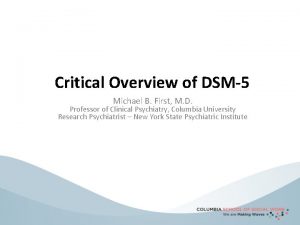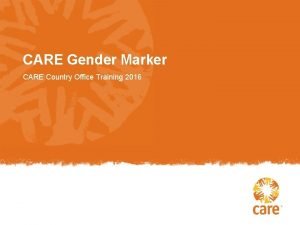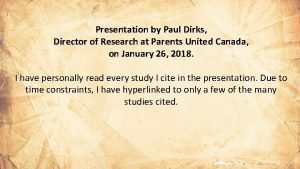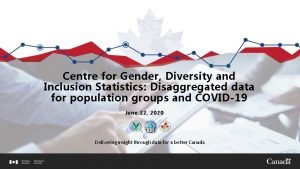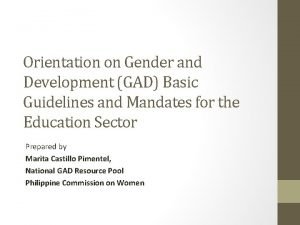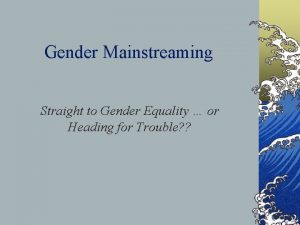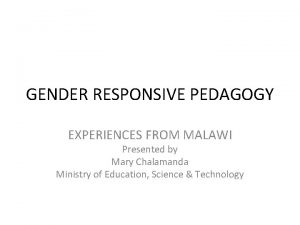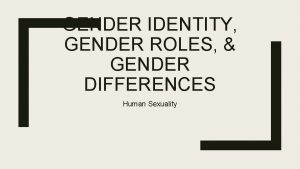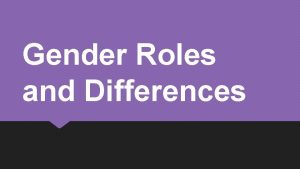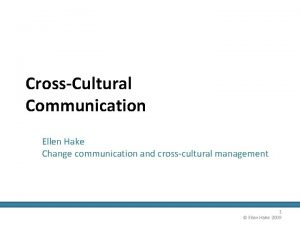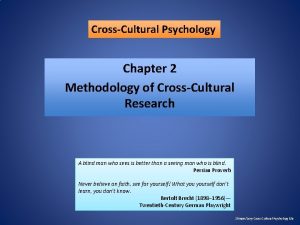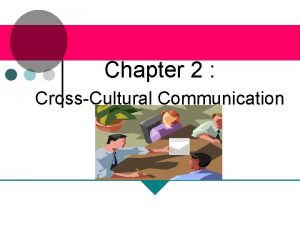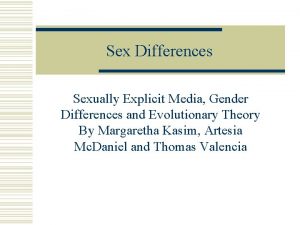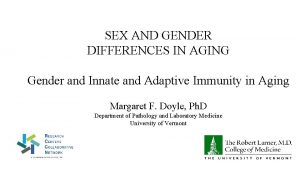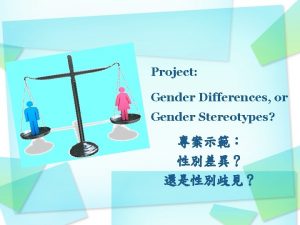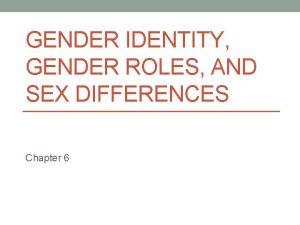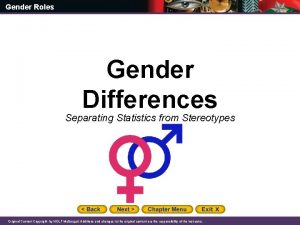Gender differences in reading from a crosscultural perspectivethe





















- Slides: 21

Gender differences in reading from a cross-cultural perspectivethe contribution of gender equality David Reilly, School of Applied Psychology, Griffith University Australia For a copy of this paper, email d. reilly@griffith. edu. au

Literature on reading gender differences n n Gender differences exist for sex-typed cognitive abilities, such as reading and mathematics On average, girls outperform boys on reading comprehension ¨ Finding appears to be ‘stable’ across decades ¨ Not necessarily explained by the dyslexia prevalence in boys n n n Many assessments exclude students with a diagnosis of dyslexia Finding applies to the middle of the ability distribution as well as the extreme tails Researchers have focused on biological and social explanations, with cultural factors less researched

Gender equality n Baker and Jones (1993) proposed the gender stratification hypothesis ¨ Briefly, it suggests that group differences in performance between men and women are socially constructed ¨ Greater segregation of men and women’s roles in society results in larger gender differences… more gender equal societies will have reduced gender differences ¨ Hypothesis can be easily tested by examining the magnitude of gender differences cross-culturally

International gender differences n n n International assessments of student achievement provide an opportunity to test such a hypothesis The largest educational assessment is PISA, the Programme for International Student Assessment, conducted by the OECD, and repeated every three years. It measures students ability in reading, mathematics and science at age 15, using very large nationally representative stratified samples. – approximately 480, 000 in PISA 2009

PISA Reading Achievement n Gender differences in reading literacy were found across all nations ¨ Finding would be consistent with biological contributions n Magnitude of gender differences varied considerably from country to country ¨ Finding factors would be consistent with sociocultural

Gender differences in reading globally Effect size, Cohen’s d. Reported in Reilly (2012)

Gender equality n Measuring gender equality ¨ Domain specific outcomes n n n ¨ Composite measures n n ¨ Female to male wage gap Percentage of women in the labour force Percentage of researchers/technical professionals that are women Health outcomes Educational access Economic participation Political representation Advantage of using objective measures (collected by nongovernmental organisations) is that it avoids self-report bias, and readily accessible to researchers

Research findings n To date, only two studies have examined gender equality and reading comprehension: Guiso, et al. , (2008). Culture, gender, and math. Science, 320(5880), 1164 -1165. doi: 10. 1126/science. 1154094 Reilly (2012). Gender, culture and sex-typed cognitive abilities PLo. S One, 7(7), e 39904. doi: 10. 1371/journal. pone. 0039904 n Both examined PISA assessments

Guiso et al. , (2008) findings n Guiso et al. , analysed the 2003 wave of PISA for mathematics and reading comprehension ¨ Employed the Gender Gap Index (GGI) as measure of gender equality ¨ Composite measure across four domains Economic participation n Education (primary, secondary, tertiary) n Political representation n Health (life expectancy ratio and sex ratio at birth) n

Guiso et al. , (2008) findings Key Findings: Mathematics Inequality appears to have a suppression effect on womens’ reading achievement, and greater equality allowed their natural ability to flourish Gender gap decreased in more gender equal nations, consistent with the gender segregation hypothesis Reading comprehension Surprisingly, the gender gap actually increased in more gender equal nations

Reilly (2012) findings n Reilly (2012) analysed PISA 2009 dataset ¨ Offers expanded coverage with now 65 nations ¨ Inclusion of more non-Western participants ¨ Approximately 480, 000 students assessed n Employed multiple measures of gender equity to test gender stratification hypothesis for reading, maths and science ¨ Gender Gap Index (GGI) used by Guiso et al. ¨ Relative Status of Women (RSW), measuring only education, life expectancy and income imbalance ¨ Women in Research / Technical Professions (WIR)

Reilly (2012) findings n Reading achievement ¨ Overall gender gap in reading across countries Cohen’s d = -. 44 [95%CI = -. 41 to -. 46] ¨ Bivariate correlations between gender equity measures significant for RSW, r = -. 33, and WIR, r = -. 38 but not GGI, r =. 01.


Reilly (2012) findings To further investigate these associations, the three gender equity measures were entered as predictors into a meta-regression. Dependent variable is the magnitude of the gender difference in reading.

Reilly (2012) findings Table 2 Meta-Regression Results for Gender Equality as a Moderator of Gender Gap in Reading (PISA 2009) Regression coefficient Z-score P-Value (2 -tailed) Betamake (β) a significant Both coefficient unique contribution, even Arepresent though they. 00 slightly different constructs Intercept . 80 . 422 GGI . 67 . 503 RSW -3. 06 . 002 ** -. 43 WIR -1. 98 . 047 * -. 25 . 09 Note: Missing gender equality measures were present for some nations, leading to a reduced sample (k= 46)

Reilly (2012) findings n n GGI measure includes political representation as a key element, which may be less strongly associated than employment segregation (WIR) or educational/economic disparities (RSW) Need for further replication with future PISA datasets (PISA 2012).

PISA 2012 Dataset Overall gender gap in reading across countries Cohen’s d = -. 43 [95%CI = -. 40 to -. 47] Table 4 Meta-Regression Results for Gender Equality as a Moderator of Gender Gaps in Reading (PISA 2012) Z-score P-Value (2 -tailed) Intercept 1. 80 . 070 GGI -. 74 . 456 RSW -2. 69 . 007 ** -. 34 WIR -2. 48 . 013 * -. 30 Regression coefficient Beta coefficient Consistent direction, and (β) similar sized beta weights – appears stable across. 00 of assessment waves -. 09 Note: Missing gender equality measures were present for some nations (k= 45).

Mechanisms Gender differences in reading ability are associated with some measures of gender equality. But is this a causal relationship? Gender gap in reading Gender equity Third factor Are we measuring something else (unconscious bias against women, gender stereotypes, etc)?

Additional PISA findings n n n PISA also measures student achievement in mathematics and science literacy, two areas traditionally associated with greater male performance Examining the PISA 2009 assessment for mathematics, only partial support for the gender segregation hypothesis was found. The women in research measure showed a negative correlation with mathematics, r = -. 38 with smaller gender gaps in more equitable nations. This is consistent with the direction found by Guiso et al. However only a weak relationship was found with RSW and no association with the GGI.

Additional PISA findings n n n For science achievement, despite gender stereotypes to the contrary girls scored higher than boys cross-culturally, particularly in non-OECD partner nations. There was a significant positive association between the GGI and science achievement, r =. 29 with greater gender equality being associated with smaller gaps. However there was also a significant negative association with the percentage of women researchers, r = -. 39 with larger gender gaps favouring females in more gender equal nations Interpretation: Increased gender equity was associated with more equal science performance, but this was offset by higher female performance as the share of women in research positions increased.

Summary There is strong support for the gender segregation hypothesis with measures reading literacy There is mixed support for gender equality associations with mathematics and science literacy. Choice of gender equality measure is important, with stronger associations being found with domain measures (e. g. such as women in research) than composite measures
 Strategic gender needs and practical gender needs
Strategic gender needs and practical gender needs While reading activities
While reading activities Aims and objectives of teaching
Aims and objectives of teaching Real definition of extensive reading
Real definition of extensive reading What is intensive reading
What is intensive reading Extensive reading
Extensive reading Edb net
Edb net How to develop reading skills in students
How to develop reading skills in students St. louis
St. louis According to gary goshgarian, critical reading is
According to gary goshgarian, critical reading is Feminist criticism
Feminist criticism Orbital diagonal rule
Orbital diagonal rule Karens nnn
Karens nnn Sample dsm-5 diagnosis format
Sample dsm-5 diagnosis format Care gender marker
Care gender marker Gender
Gender Centre for gender diversity and inclusion statistics
Centre for gender diversity and inclusion statistics Sample lesson plan in gender and development
Sample lesson plan in gender and development Gender equality definition
Gender equality definition Gender responsive pedagogy
Gender responsive pedagogy Schema evaluation
Schema evaluation Echogender
Echogender













